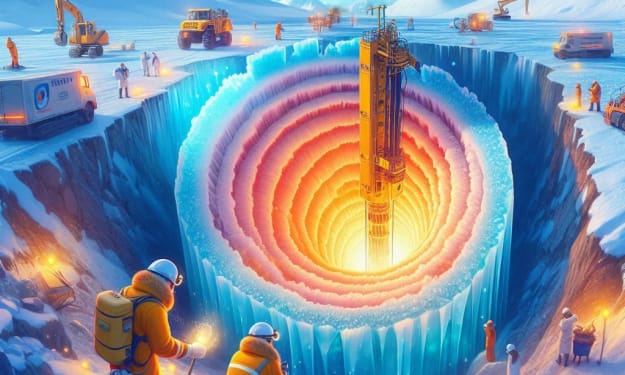Ice has been melting alarmingly fast in the past, raising concerns about sea level rise
The ice melts surprisingly fast

Studies of ancient beaches and fossilized coral reefs suggest that sea levels may be rising much faster than current models predict, according to geologists who have studied past warming periods.
At one point in a comparable period, sea levels were rising at a rate of 3 meters per century, or 30 millimeters per year, according to Dr. Fiona Hibbert, a geologist at the University of York in England. The current rate of increase is 3.2 millimeters per year.
Dr. Hebert is working on a project called ExTaSea, which predicts the worst-case scenario of global sea level rise. Its goal is to help decision-makers make long-term decisions, such as about the siting of enduring infrastructure such as nuclear power plants.
Designing models that can make such predictions are notoriously difficult, she says.
"We're not entirely sure of all the processes involved. When you melt an ice cap, sometimes it's long in scale, and that's hard to put into a model."
And melting itself changes the whole system - for example, by relieving the load on the crust, which then undergoes a slow rebound over thousands of years.
A further problem is that the most recent sea level data only go back 150 years (tide measurements) and 20-25 years (satellite measurements).
Because of this, geologists such as Dr. Hebert and geologist Professor Alessio Rovillet of the University of Bremen in Germany are reviewing what happened during the last interglacial.
"The geological record is great because it includes all the processes," says Dr. Hibbert.
We are living in the Holocene interglacial. "For the last 6,000 years, humans have enjoyed the fairly stable climate and sea level conditions and have prospered as a result," said Professor Rovelli.
The most similar to the Holocene in geological history is the last interglacial, which occurred between 125,000 and 118,000 years ago. During this period, global temperatures were about one to two degrees warmer than the baseline temperatures used to measure climate change before industrialization because of the Earth's slightly different tilt and orbit.
Geologists can find clues to sea levels at this time from fossilized coral reef seas when trapped in cliff layers flattened, as well as small chemical compositions, marine organisms known as foraminifera, giving an idea of the sea's past, Dr. Hibbert said.
Professor Rovere is also looking at what the ancient beaches (which also became rock formations on the cliffs) can tell us.
"Today's beaches have sand formed along the shoreline ...... Imagine that all of these ...... can be frozen in time as they become rocky." So we can go back and look at the rocks that used to be the beach." Looking at their features and the shells preserved inside, he said, "we can relate them to the changing sea level."
However, sorting out the right information from stranded reefs and beaches can be tricky. The receding seawater may leave its remnants in one place, only for them to be lifted or dropped by subsequent geological activity.
Professor Rovelli encountered these problems while trying to solve the puzzle of the massive boulders on the 15-meter-high cliffs of Iliosira Island in the Bahamas. While some researchers believe they were thrown there by a superstorm, others, including him, believe that higher sea levels combined with smaller storms are the culprits.
Despite these challenges, Dr. Hebert synthesized analyses of ancient coral reefs done by scientists around the globe and concluded that sea levels are rising at a "very high" rate - up to 3 meters per century, "which is about 10 times the current rate. 10 times the current rate."
Professor Rovelli is collecting data on geological features such as ancient corals and beaches to create a database that will help provide a nuanced story of how sea levels changed in different areas and the strength of waves during the last interglacial.
Interpreting geological data is difficult, so Professor Rovelli is also using models more commonly used by engineers to understand the effects of waves and currents on harbors, which can help him understand how sand was deposited on the coast during the interglacial.
He says: By combining these two different disciplines, "we can learn more about the past than just the geological interpretation of the rocks."
His work is producing slightly different numbers.
He says: "There are features in some of the rock records that lead us to believe that at some point during this warm period, sea level jumped from 3 meters to 6 meters." That's the equivalent of 10 millimeters per year. That increase occurred over a relatively short period, he said.
"It's really interesting because today we're in a warm period, which is natural and the cause of climate change. During the last interglacial, even if we don't warm the system, some of the data suggest that there was this jump."
This is a much-debated idea, but what if it's true? It means that the ice can melt rapidly, in addition to what we humans are doing."
Professor Rovelli says it is "almost impossible" to adapt to a sea level rise of 10 millimeters per year at a sufficient rate. "It means we'll just have to abandon our cities," he added.
The prospect of sudden acceleration in ice melt is further supported by the work of Dr. Hibbert's student, Dr. Lin Yucheng, as part of the extra project.
The reference period for this one is between 24,000 and 11,000 years ago, the most recent glacial melt on Earth, before the Holocene.
Dr. Hibbert says: "This period is fundamentally different from today, which makes us less optimistic when looking ahead." For example, there were once huge ice caps in North America and Europe.
But they found that at the peak of glacial melt, sea levels were rising by 3.6 meters per century.
Dr. Hibbert says: "Again, that's a very high number, so the mass of the ice sheet will disappear very quickly."
She is now considering how such rapid melting will have an impact on different coasts this century.
About the Creator
Enjoyed the story? Support the Creator.
Subscribe for free to receive all their stories in your feed. You could also pledge your support or give them a one-off tip, letting them know you appreciate their work.






Comments
There are no comments for this story
Be the first to respond and start the conversation.